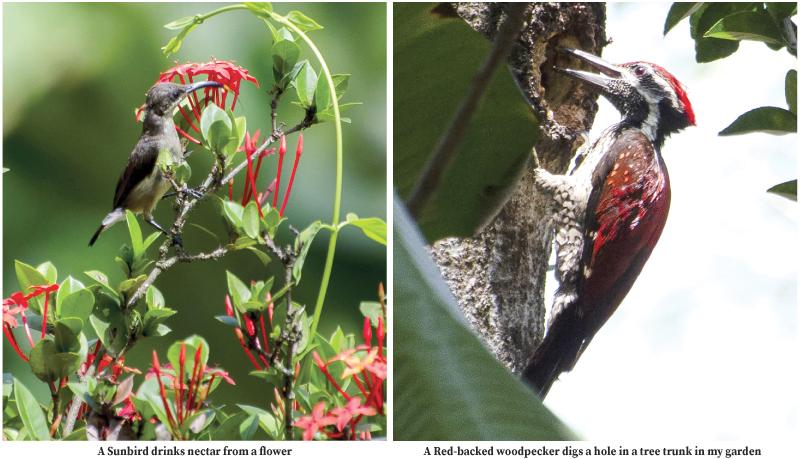
The Covid-19 curfew has kept people at home for nearly two months now. People began to do various pastimes while at home.
However, the government has banned pilgrimages, pleasure tours and picnics until further notice. As a traveller and a photographer, I too am restricted in my travelling. So, I began to capture birds’ life during this lockdown period, apart from helping my wife in her home gardening.
Koha is a popular bird in the month of April. I used to hear its wake up call every morning, but I don’t hear its usual call nowadays. I live in a village by the mountains, in an extremely rural set up. I can’t express in words my joy when I am woken up by birds’ songs. There’s a wooded land around my home, which is home to a number of birds. They have always been there. Since everyone is at home due to curfew and there’s silence out there, I could hear them clearly. In fact, I could discern around eight different birdcalls early in the day.
As noise pollution is minimal there is more bird movement in the rural settings and even in urban areas. A couple of songbirds are building a nest on a mango tree in my garden, in Ratnapura. This bird is rarely spotted in the city. In fact, lockdown seems to be the best time to appreciate the natural world around us.
 I decided to study the behaviour of these birds and captured them digitally. Placing my camera on a tripod, I captured and kept track of the number of birds from time to time, from 7 am to 4 pm.
I decided to study the behaviour of these birds and captured them digitally. Placing my camera on a tripod, I captured and kept track of the number of birds from time to time, from 7 am to 4 pm.
Interestingly, I found that more birds were captured digitally on the days of curfew as I did this exercise at home. When you observe birds’ behaviour, they seem to be happily calling out to each other from long distances. Looking out of the window from the rear balcony there is so much to see; birding makes one happy, a much-needed feeling at this time of isolation.
Morning is the best time to spot birds because after the prolonged fasting during the night, birds wake up with the dawn of light, and their first task is going out for breakfast. One can spot at least 10 bird species in the backyards that have green cover.
These include the House Sparrow whose numbers have been dwindling; Tailor bird, Sunbird, Asian Koel, and the Coucal. The white-throated Kingfisher could be spotted too which is commonly seen around water bodies. The month of March being a flowering season for plenty of trees, birds flock to feed on the sweet berries. The Black-hooded Oriole and Brown-headed Barbets head to the berry trees to feed on their fruit.
In fact, it’s among the best seasons to bird watch when many trees have flowered. Bees buzz around the rubber trees that blossom with fresh tender leaves emanating a sweet smell. At night, I keep my ears pricked for calls of the Ulama (devil bird). Owls come out, and I could also hear the boisterous voice of bats quarreling, swooping down to eat ripe banana and jackfruit in the garden.
The birds were like my neighbours then. I have studied their behaviour well during those days which was essentially keeping track of the trees in my garden. Papaw, when it’s ripe attracts many birds such as the brown-headed barbet, mynah and the Asian koel. I was also able to see a Red-backed woodpecker which dug a hole on a tree trunk and heard many bird voices since there was no other noise around. This might be inexplicable phenomena due to the Covid-19 curfew.
Usually, from the beginning of March to April, mango trees are full of fruits, with the flowering trees blossoming. This year, everyone being stuck at home, the mango tree is laden with a bountiful harvest, and more birds are coming out to frolic.
Also reaping the benefit of the absence of humans, are the songbirds that usually need a very quiet surrounding before they come out and sing. In the past month, I have been seeing and hearing robins as well in the nearby trees. I even saw a group of Sunbirds from my balcony. The peace and calm we left behind is encouraging them to spend more time in the garden.
Many small creatures were waiting to be discovered: insects, spiders, garden lizards, earthworms are a few common ones among them. Insects by far were the greatest in variety. At home, depending on the number of bushes and trees around, you can easily spot the grasshopper, moth, butterflies and the troublesome mosquito.
Medical experts have said that birding can be therapeutic. There are studies that show that the exercise can have a ‘healing effect on people with depression.’ There are plenty of resources online regarding this.
I could hear the sound of a couple of Black-hooded Orioles outside my balcony as I type this article.

